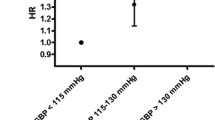Summary
The recent development of ambulatory blood pressure (ABP) monitoring techniques has improved recording of blood pressure in therapeutic trials and in the clinical setting. The application of ABP differs according to which of these 2 applications is being considered.
In therapeutic trials, a placebo control is required. The large quantity of precise data acquired with ABP monitoring allows the study of a limited number of patients; it also allows individual study of patients with a ‘white coat’ response (i.e. elevated blood pressure in response to examination by the clinician). Analysis of data from ABP monitoring may include the following: comparison of mean blood pressure values over 24 hours, daytime or night-time, or over any other selected time period; 24-hour blood pressure profiles, or analysis hour-by-hour, giving true chronotherapy, and providing data regarding the wearing-off of a drug effect or loss of therapeutic control; analysis of blood pressure at particular times, such as on waking; or specific examination of nonresponders.
In individual patients, ABP monitoring should be reserved for specific indications. It can be used before initiation of treatment to confirm the necessity for treatment, especially in the context of hypertension at rest or the ‘white coat’ effect. With established treatment, ABP monitoring can be used in patients with resistant hypertension, in severe hypertension to examine loss of blood pressure control over time or inversion of the day/night cycle, and in patients with a specific illness, e.g. diabetes, in order to obtain the lowest blood pressure readings possible.
Examination of these factors assists clinicians to accurately decide upon the timing and frequency of antihypertensive therapy.
Similar content being viewed by others
References
Battistella P, De Gaudemaris R, François G, Lyon A, Gosse P, et al. Valeurs de référence de la tension artérielle en ambulatoire d’activité et de nuit. Etude multicentrique de 394 sujets normotendus au repos. Archives des Maladies du Coeur et des Vaisseaux 82: 1019–1022, 1989
Coats A, Conway J, Somers VK, Isea JE, Sleight P. Ambulatory pressure monitoring in the assessment of hypertensive therapy. Cardiovascular Drugs and Therapy 3: 303–311, 1989
De Gaudemaris R, Mallion J-M, Battistella P, Battistella B, Siché JP. Ambulatory blood pressure and variability by age and sex in 200 normotensive subjects: reference population values. Journal of Hypertension 5(Suppl. 5): 429–430, 1987
Drayer JIM, Weber MA. Definition of normalcy in whole-day ambulatory blood pressure monitoring. Clinical and Experimental Hypertension 7: 195–204, 1985
Kennedy HL, Horan MJ, Sprague MK, Padgett NE, Shriver KK. Ambulatory blood pressure in healthy normotensive males. American Heart Journal 106: 717–722, 1986
Mallion JM, Siché JP, De Gaudemaris R, Maître A. Mesure de la pression artérielle en ambulatoire. Intérêt et limites. Presse Médicale 6: 245–246, 1990
Mancia G, Bertinieri G, Grassi G, Parati G, Pomidossi G, et al. Effects of blood pressure measurement by the doctor on patient’s blood pressure and heart rate. Lancet 2: 695–698, 1983
Muller JE, Ludmer PL, Willich SN, Tofler GH, Aylmer G. Circadian variation in the frequency of sudden cardiac death. Circulation 75: 131–138, 1987
Nunez P, Siché JP, Maître A, Mansour P, Pitiot M, et al. Etude chronothérapeutique du vérapamil LP 240 dans l’hypertension artérielle légère à modérée. Archives des Maladies du Coeur et des Vaisseaux 83: 49, 1990
O’Brien E, Murphy J, Tyndall A, Atkins N, Mee F, et al. Twenty-four-hour ambulatory blood pressure in men and women age 17–80 years: the Allied Irish Bank Study. Journal of Hypertension 9: 355–360, 1991
Pickering TG, Harshfield GA, Devereux RB, Laragh JH. What is the role of ambulatory blood pressure monitoring in the management of hypertensive patients? Hypertension 7: 171–177, 1985
Porchet M, Bussien JP, Waeber B, Nusserger J, Brunner HR. Unpredictability of blood pressure recorded outside the clinic in the treated hypertensive patient. Journal of Cardiovascular Pharmacology 8: 332–335, 1986
Trazzi S, Mutti E, Frattola A, Imholz B, Parati G, et al. Reproducibility of non-invasive and intra-arterial blood pressure monitoring: implications for studies on antihypertensive treatment. Journal of Hypertension 9: 115–119, 1991
Weber MA, Cheung DG, Graettinger WF, Lipson JL. Characterization of antihypertensive therapy by whole-day pressure monitoring. Journal of the American Medical Association 259: 3281–3285, 1988
Author information
Authors and Affiliations
Rights and permissions
About this article
Cite this article
Mallion, JM., Maitre, A., de Gaudemaris, R. et al. Use of Ambulatory Blood Pressure Monitoring in the Management of Antihypertensive Therapy. Drugs 44 (Suppl 1), 12–16 (1992). https://doi.org/10.2165/00003495-199200441-00003
Published:
Issue Date:
DOI: https://doi.org/10.2165/00003495-199200441-00003




